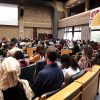Monday, May 13, 2024
News and Views from the Global South
CUBA: Children Use Art to Learn About Hunger
Patricia Grogg
- A Cuban child is drawing a train, heavily loaded with emergency food supplies that are about to be airlifted and dropped into areas where hunger is just a normal part of life. The drawing will be entered in an annual international competition called “WFP in Action,” organised by the World Food Programme.
The subject may seem to be beyond the comprehension of children, but every five seconds an under-five child dies of malnutrition-related diseases, making it an everyday occurrence for people in poor countries, the WFP says.
Jorge Jorge González, who teaches drawing and painting at a community cultural workshop on the outskirts of Havana, says that early learning about environmental and nutritional issues will help “future generations to be more aware of the damage we have done to our planet.”
“If these children, who are the scientists, engineers and teachers of the future, learn about these things, they will be able to make a contribution, however small, to improving the situation later on,” Jorge González told IPS.
The art teacher, who is also a town councillor, has taught the basic principles of painting to children under 12 since 2004. The community centre, “Coloreando Mi Barrio (Colouring My Neighbourhood)”, aims to educate children so that they will be “better prepared for life in society,” he said.
In fact, the education project involves the whole family, so that parents are also motivated to find out about topics as varied as malnutrition, ozone depletion in the atmosphere, and global water resources.
“One of the most important things the workshop has achieved, apart from the technical and practical results of the drawings, is that people are more cultured and really knowledgeable,” said Jorge González.
Turning the traditional model of education on its head, it is now the children who are, in a sense, educating the adults in their families.
Marta Lomas, Cuba’s minister of Foreign Investment and Economic Cooperation, said that initiatives like “WFP in Action” contribute to an understanding of proper nutritional values, and children have a big impact because they learn about food quality, and they identify with the WFP’s aims.
Cuba has participated in the drawing contest since 1998. However, cooperation with the WFP began in 1963 – the year the programme was created – when the United Nations agency sent aid for the victims of hurricane Flora, which had devastated eastern parts of this Caribbean island nation.
Since then, the WFP has sponsored five farming development and nutritional support projects for vulnerable population groups and 11 emergency operations in aid of victims of natural disasters, and has supervised a Japanese donation of rice to Cuba, worth 237 million dollars.
“From the outset, the collaboration between the WFP and Cuba has been based on the principles of respect and on each country’s own priorities, and I think that has ensured its success,” Lomas told IPS. She said she was satisfied with “the recognition of the government’s efforts to feed its people.”
The minister said that the economic crisis in Cuba in the 1990s restricted food supplies all over the country, but more acutely in the eastern provinces, which were afflicted by a decade-long drought until 2006. In the circumstances, people adopted poor eating habits, such as not consuming enough green vegetables.
Since 2002, a WFP project has provided food aid in five provinces in the east of the island. Grains enriched with iron to prevent anaemia are distributed to persons over 65, pregnant women and children under five, and fortified school lunches and snacks are provided in primary schools and day care centres.
The project also offers training in nutrition, health and food hygiene, with the goal of fomenting nutritional and health education in healthcare centres, schools and the general public.
The 10th anniversary of the “WFP in Action” drawing competition in Cuba was celebrated on May 4 in Havana. A commemorative postage stamp was issued, depicting a drawing on the theme of breastfeeding which took a prize in 2004.
Many drawings from Cuba have won prizes in the international children’s art contest. This says a lot about the development of painting, and culture in general, in Cuba, said WFP assistant executive director Jean-Jacques Graisse. The number of drawings submitted by Cuba rose from 76 in 1998 to 1,176 in 2006.
Graisse said he was pleased that the government formally celebrated the annual event, in which thousands of Cuban children have participated. He also thanked Cuba for its contribution of 2,500 tons of sugar for WFP programmes around the world.
“It is moving to see how children draw the difference food makes in their lives,” Graisse said. “Some paint their school dining hall, and some draw planes dropping food supplies, as the WFP does in Darfur (Sudan).”
According to the WFP report “Hunger and Learning”, published in 2006, “hunger in childhood can lead to irreversible mental stunting, lower intelligence quotients (IQs) and reduced capacities to learn.”
“The effects are tragic for individuals and staggering for nations,” the report says, because severe nutritional deficits reduce people’s opportunities and delay their human development. If large sectors of the population are affected, malnutrition is a serious obstacle to a nation’s economic development, it added.

 Print
Print



